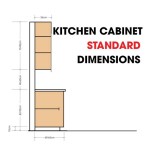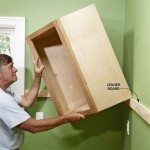How To Remove Oil Stains From Wooden Kitchen Cabinets
Wooden kitchen cabinets, prized for their aesthetic appeal and durability, are often susceptible to oil stains due to their proximity to cooking areas. Splatters from frying, sautéing, and general food preparation can leave unsightly marks that, if left untreated, can become deeply ingrained and difficult to remove. Effective oil stain removal requires a strategic approach, utilizing appropriate cleaning agents and techniques that are safe for wood finishes. This article provides a comprehensive guide to removing oil stains from wooden kitchen cabinets, outlining various methods and preventative measures to maintain their pristine condition.
Identifying the Type and Severity of the Stain
Before initiating any cleaning process, it is crucial to accurately assess the type and severity of the oil stain. Fresh oil stains, which are still wet or relatively new, are generally easier to remove compared to older, dried-in stains. Identifying the type of oil—cooking oil, grease, or other oily substances—can also influence the choice of cleaning agent. Observe the stain's color and texture. Darker, thicker stains typically indicate a longer duration and potentially deeper penetration into the wood's porous surface. Some stains may also be accompanied by a sticky residue, further complicating the cleaning process. A careful initial assessment minimizes the risk of using improper methods that could potentially damage the cabinet's finish.
The finish type on the cabinets is another crucial aspect to consider. Cabinets might have a varnish, lacquer, polyurethane, or painted finish. Each finish reacts differently to cleaning agents. Applying the wrong cleaner could strip the finish, leading to discoloration and damage. Checking manufacturer guidelines or testing a small, inconspicuous area is always recommended before proceeding with any cleaning solution.
Understanding the wood type is also helpful. Certain woods are more porous than others. Porous woods like oak will absorb oil stains more readily than denser woods like maple. This affects the application time and the number of treatments that may be necessary to remove the stain effectively.
Effective Cleaning Methods for Oil Stains
Various methods can be employed to remove oil stains from wooden kitchen cabinets. The chosen method should align with the stain's severity, the cabinet's finish, and the available resources. Starting with the gentlest approach and gradually escalating to more intensive methods minimizes the risk of damage.
1. Using Dish Soap and Water: This is often the first line of defense for fresh or relatively light oil stains. Dish soap is formulated to cut through grease and oil, making it an effective cleaning agent. Prepare a solution of warm water and a few drops of mild dish soap. Dip a soft cloth or sponge into the solution, wring out excess water, and gently wipe the stained area. Avoid using excessive water, as it can seep into the wood and cause damage. Rinse the area with a clean, damp cloth and dry thoroughly with a soft towel. Multiple applications may be necessary to fully remove the stain.
2. Baking Soda Paste: Baking soda is a mild abrasive and absorbent agent that can effectively lift oil stains from wood surfaces. Create a paste by mixing baking soda with a small amount of water until a thick consistency is achieved. Apply the paste to the oil stain, ensuring it covers the entire affected area. Allow the paste to sit for at least 30 minutes, or longer for stubborn stains, to allow the baking soda to absorb the oil. Gently scrub the area with a soft brush or cloth, using circular motions. Wipe away the paste with a damp cloth and dry thoroughly. Repeat the process if necessary. This method is particularly effective for porous wood surfaces.
3. Vinegar Solution: Vinegar, a natural cleaning agent, can help dissolve oil and grease. Create a solution of equal parts white vinegar and water. Dampen a soft cloth with the solution and gently wipe the oil stain. Avoid saturating the wood with the vinegar solution. Rinse the area with a clean, damp cloth and dry thoroughly. Vinegar's acidic properties can potentially damage certain finishes, so testing on an inconspicuous area is highly recommended. For tougher stains, leave the solution on the stain for a few minutes before wiping it down.
4. Commercial Degreasers: For stubborn or deeply ingrained oil stains, commercial degreasers specifically designed for kitchen surfaces may be necessary. Choose a degreaser that is safe for use on wood and follow the manufacturer's instructions carefully. Always test the product on an inconspicuous area before applying it to the entire stained area. Apply the degreaser to a soft cloth and gently wipe the stain. Avoid spraying the degreaser directly onto the cabinet surface. Rinse the area with a damp cloth and dry thoroughly. Ensure proper ventilation when using commercial degreasers.
5. Mineral Spirits: Mineral spirits, also known as white spirits, are a stronger solvent and should be used with caution. Mineral spirits are effective for dissolving oil-based stains and residues. Always work in a well-ventilated area and wear gloves when using mineral spirits. Dampen a clean cloth with mineral spirits and gently wipe the stained area. Be careful not to over-saturate the wood. Immediately wipe the area with a clean, dry cloth to remove any remaining mineral spirits. Mineral spirits can strip the finish from the wood, so it's crucial to work carefully and test on an inconspicuous area first.
6. Ironing Method: This method works best for stains that have penetrated the wood but haven’t damaged the finish. Place a clean, absorbent cloth, such as a paper towel or cotton rag, over the oil stain. Set an iron to a low or medium setting (without steam) and gently iron over the cloth. The heat from the iron will help to draw the oil out of the wood and into the cloth. Check the cloth frequently and replace it with a clean section as it absorbs the oil. Repeat the process until no more oil is transferred to the cloth. This method can be especially effective for older, set-in stains.
Preventative Measures to Minimize Future Oil Stains
While effective cleaning methods are essential for removing oil stains, implementing preventative measures can significantly reduce their occurrence and severity. Proactive steps can safeguard wooden kitchen cabinets and maintain their aesthetic appeal.
1. Regular Cleaning: Incorporate regular cleaning into your kitchen maintenance routine. Wipe down kitchen cabinets with a damp cloth and mild dish soap solution after cooking to remove any grease or oil splatters before they have a chance to set. This simple habit can prevent the build-up of oil stains and make cleaning easier in the long run. Pay close attention to areas around the stovetop and sink, where oil splatters are most likely to occur.
2. Using Backsplashes: Installing backsplashes behind the stovetop and sink provides a protective barrier against oil splatters and water damage. Backsplashes, made from materials such as tile, glass, or stainless steel, are easier to clean than wood cabinets and can effectively prevent stains from reaching the wood surface. Choose a backsplash material that complements the kitchen's aesthetic and is durable and easy to maintain.
3. Proper Ventilation: Adequate ventilation in the kitchen reduces the build-up of airborne grease and oil particles, which can settle on cabinet surfaces and contribute to staining. Use the range hood while cooking to exhaust fumes and grease. Open windows and doors to improve air circulation. Consider installing a more powerful range hood if the existing one is inadequate.
4. Immediate Spill Cleanup: Address spills and splatters immediately as they occur. The longer oil sits on the wood surface, the more likely it is to penetrate and stain. Use a clean cloth or paper towel to blot the spill and prevent it from spreading. Follow up with a mild cleaning solution, as described earlier, to remove any remaining residue.
5. Protective Coatings: Applying a protective coating to wooden kitchen cabinets can help prevent oil stains from penetrating the wood surface. Consider using a sealant or varnish specifically designed for kitchen cabinets. These coatings create a barrier that repels oil and water, making cleaning easier and preventing long-term damage. Reapply the coating periodically as needed to maintain its protective properties. Be sure to follow manufacturer instructions for application and maintenance of these protective coatings.
6. Using Placemats and Coasters: Although not directly related to cooking oil, placing placemats and coasters on countertops can also prevent oil-based stains from food containers or condiments stored on the countertops near the cabinets. This helps maintain a cleaner environment around the cabinets and prevents secondary stains.
By understanding the nature of oil stains, employing appropriate cleaning methods, and implementing preventative measures, individuals can effectively remove and minimize the occurrence of oil stains on their wooden kitchen cabinets, preserving their beauty and extending their lifespan. Regularly inspecting cabinets for signs of oil buildup and promptly addressing them further contributes to maintaining a clean and aesthetically pleasing kitchen environment.

How To Clean Kitchen Cabinets Everyday Skate

How To Remove Grease From Kitchen Cabinets 3 Methods Bob Vila

We Tried 5 Methods To Clean Greasy Wood Cabinets And The Winner Is Ridiculously Effective Kitchn Cleaning Kitchen

How To Clean Sticky Grease Off Kitchen Cabinets Ovenclean
:max_bytes(150000):strip_icc()/ways-to-clean-wood-kitchen-cabinets-3017289-00-fb8e5ae9eb004ec6b968f9d53e74cd1e.jpg?strip=all)
Tips For Cleaning Food Grease From Wood Cabinets
:max_bytes(150000):strip_icc()/ways-to-clean-wood-kitchen-cabinets-3017289-01-765f893e7cca49a1ab72d7c49efdf518.jpg?strip=all)
Tips For Cleaning Food Grease From Wood Cabinets

How To Remove Greasy From Kitchen Cabinets Home Cleaning Tips

How To Clean Sticky Grease Off Kitchen Cabinets Infinity

5 Expert Ways To Clean Wooden Kitchen Cabinets Everyday Old House

4 Proven Ways To Clean Sticky Wood Kitchen Cabinets Lovetoknow
Related Posts








